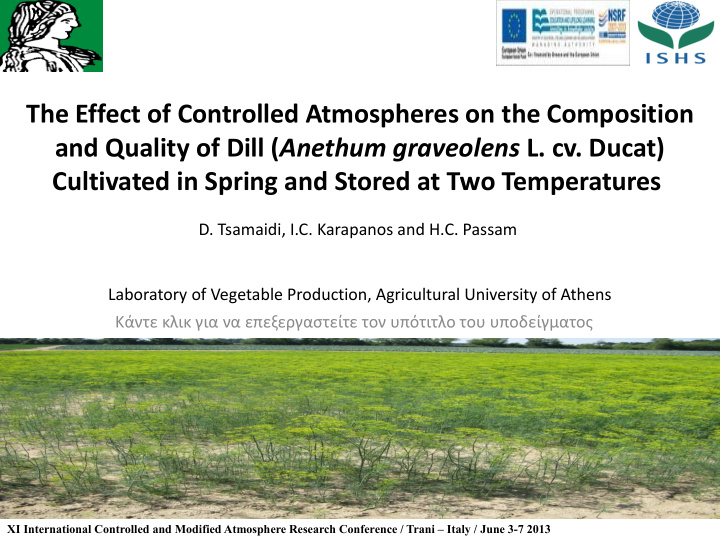



The Effect of Controlled Atmospheres on the Composition and Quality of Dill ( Anethum graveolens L. cv. Ducat) Cultivated in Spring and Stored at Two Temperatures D. Tsamaidi, I.C. Karapanos and H.C. Passam Laboratory of Vegetable Production, Agricultural University of Athens Κάντε κλικ για να επεξεργαστείτε τον υπότιτλο του υποδείγματος XI International Controlled and Modified Atmosphere Research Conference / Trani – Italy / June 3-7 2013
Introduction Ø Dill is an aromatic and annual herb of Apiaceae family Ø Dill is native of the Mediterranean region and Southern Russia Ø Dill grows wild within the Mediterranean area but rarely occurs as a weed in Northern Europe Ø The genus name Anethum is derived from Greek word “ aneeson ” or “ aneeton ” , which means strong smelling Ø Cultivated in Europe, North America and Asia Ø India is the world leader in production of dill, followed by China, Mexico and Spain
Uses Ø Culinary uses flavouring soups, sauces, etc • Dill vinegar is a popular household condiment • Dill seeds for flavouring cakes, pastry and sauces • Ø Medicinal uses ü possess stimulant, aromatic, carminative and stomachic properties ü Antimicrobial, antihyperlipidemic, antihypercholesterolic and antioxidant activities Ø Insecticide use ü Some compounds of dill (d-carvone), when added to insecticides greatly increase their effectiveness
Objecive The objective of this experiment was to determine the effect of high CO2 and storage temperature on the storage behavior and quality characteristics of dill cultivated in spring
MATERIALS AND METHODS Ø Dill leaves of cultivar “Ducat” Ø Storage temperature: 2 οC and 5οC Ø Duration of storage: 14 days Ø Duration of cultivation: 16/01/2010 - 19/05/2010
Applied treatments • CO2 increase with a constant rate of O2 Ø A0: Fresh Ø Α1: 20-0-80 Ø Α2: 20-5-75 Ø Α3: 20-10-70 Ø Α4: 20-15-65
Ø Measurements before and after storage ü % weight loss after 14 days storage at 2 and 5oC ü Quality characteristics ü Chlorophyll concentration ü Vitamin C concentration ü Carotenoids concentration ü Total phenolics concentration (spectrophotometric measurement method) ü % Dry matter (after drying at 72οC) ü Ο2 consumption + CO2 production The results were subjected to analysis of variance (ANOVA) and means ü
Results Effect of controlled atmospheres on % weight loss of dill leaves % Weight loss Varied between 7 and • 20 18 12% at 2oC and 13 and 16 17% at 5oC 14 irrespective of the gas 12 composition. 10 8 Was significantly 6 higher at 5oC than at 4 2oC, except in 2 0 treatment A3.
Effect of controlled atmospheres on the dry matter content of dill leaves % Dry matter • Increased during storage at both temperatures. Was not significantly affected by the gas composition or the storage temperature.
Effect of controlled atmospheres on total chlorophyll concentration (mg/100g f.m.) Total chlorophyll (mg / 100g f.m.) • Decreased during storage in atmospheres containing 0-5% CO2 at 2oC and in those containing 0-10% CO2 at 5oC. At both temperatures, there was no loss in 15% CO2, but overall
Effect of controlled atmospheres on vitamin C concentration (mg/100 g f.m.) Vitamin C (mg / 100 g f.m.) • Decreased during storage in all treatments. At both temperatures the decrease was less at the highest CO2 level. The decrease was similar at 2oC and
Effect of controlled atmospheres on total phenolics concentration (mg/100 g f.m.) Total phenolics (mg / 100 g f.m.) • Decreased during storage at both temperatures in all treatments. At 5oC, the decrease was not influenced by the gas composition, whereas at 2oC it was greater in
The effect of controlled atmospheres on Ο2 consumption (% Ο2) after storage (15 g f.m.) • % O2 Increasing CO2 concentrations resulted in less O2 consumption at both storage temperatures. O2 consumption was higher at 5oC than at 2oC, except in treatment A3.
Conclusions Leaves stored at 2oC for 14 days in a storage atmosphere consisting of 20-15-65 (O2-CO2-N2) were fresher and greener (no chlorophyll loss) and had a higher vitamin C content than leaves stored under lower levels of CO2 or at a higher temperature (5oC).
Acknowledgements This research has been co-financed by the European Union (European Social Fund – ESF) and Greek national funds through the Operational Program "Education and Lifelong Learning" of the National Strategic Reference Framework (NSRF) - Research Funding Program: Heracleitus II. Investing in knowledge society through the European Social Fund.
Thank you for your attention
Recommend
More recommend